A new heart begins to beat

The heart transplant team at work in Operating Theatre B. Pix by Priyantha Wickramarachchi
Overjoyed is H.A. Wijaya Kumarasiri from a village in Anuradhapura. His Sudu, with her new heart beating strongly within, had opened her eyes and given him a smile that morning, as he murmured endearments to her.
We meet him the same day, Wednesday, at noon as he lingers outside the Kandy Teaching Hospital’s Cardiothoracic Intensive Care Unit (CTICU), awaiting another glimpse of his wife.
By Thursday, not only was Pushpa Kumari opening her eyes, responding when asked to move her hands and feet and also speaking, she had also been taken off the ventilator.
For Kumarasiri, a mason, Sudu and their 13-year-old daughter, Dinithi Imalsha, a humble family from Dolahela in Anuradhapura it is ‘one small step’ in the recovery of their beloved wife and mother. For the country, it is ‘one giant leap’, rocketing Sri Lanka to a place among the few centres-of-excellence performing heart transplants in the world to international standards.
Thirty-seven-year-old Kumari or Sudu is the trailblazer in the first heart transplant on the night of July 7, under Sri Lanka’s Heart and Lung Transplantation Programme performed at the Kandy Hospital, under the guidance of Director Dr. Saman Rathnayake.
In an amazing coordination effort across the country, six hospitals had come together for this pioneering effort. They are the Kandy Hospital, the Welisara Chest Hospital, the Lady Ridgeway Hospital for Children, Colombo, the Sirimavo Bandaranaike Specialized Children’s Hospital, Peradeniya and the Kurunegala and Anuradhapura Teaching Hospitals.
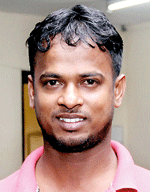
H.A. Wijaya Kumarasiri: Overjoyed husband
Kumarasiri tells us how his Sudu’s body started swelling up about a year ago but what they did not know at that time was that her heart was failing. Taken to the Anuradhapura Hospital, the state hospital system has proven to have worked perfectly, for the clinic had referred her to the Cardiology Unit there and she was diagnosed with end-stage heart failure by Consultant Cardiologists Dr. Wasantha Kapuwatte and Dr. Roshan Paranamana and sent to the Kandy Hospital.
Here too the system is working without a flaw, from the time of admission till discharge which is pending. Kumari was sent to the pre-operations ward, then onto the Operating Theatre, from where she was transferred to the CTICU and soon will be sent to the High Dependency Unit and then to the post-op ward from where she will go back home.
Up to July 12, she has been in the Kandy Hospital for two months and seven days, says Kumarasiri. “Harima bayen hitiye,” he says and how relieved he is now, “ada thama hithata sahanayak ave”, while the grandmother is looking after their daughter who is awaiting her Amma’s return.
As we chat to Kumarasiri, who showers blessings on the family who rose above their sorrow to give the heart of their only son to save Sudu’s life, seated in Director Dr. Rathnayake’s office are I.G. Nandasena, D.P.G. Indra Kalyani and M.H. Janu from Mavikumbura North off Pilimatalawa.
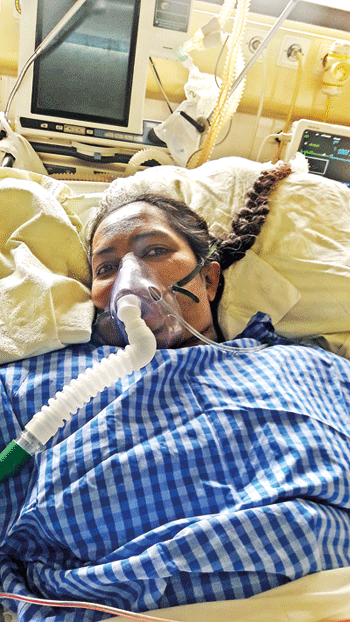
Pushpa Kumari: On the road to recovery
Nandasena and Kalyani are the father and the mother and Janu is the aunt of 21-year-old Pradeep Kumara. They will go down in Sri Lanka’s history as having done a wonderful deed, one of the greatest ‘alms’ that can be given – the donation of the heart, along with other organs, of their brain-dead Sampath, as they fondly called him.
The tragedy of his accident-death comes from his teary-eyed parents – Sampath, the middle-son between two daughters, was working in a garage with his brother-in-law. It was June 24, an overcast rainy day and the two brothers-in-law decided to close the garage and head for home early. At the turn-off on a bend to their village from the main road, their motorcycle, with Sampath on the pillion collided with a van and toppled, throwing Sampath onto a rock. He hit his head and was unconscious when rushed to the Kandy Hospital.
With absolutely no signs of Sampath regaining consciousness, the parents had been counselled and approached for organ donation, which they had readily agreed to.
“Sampath merunata, den innawa wage,” sighs Kalyani, adding that though her son is dead, it is as if he is living, for he has given life to one person through his heart, his kidneys to two more and others will see through his eyes.
Even in death, ratata harima ‘sampathak’ vuna, is the poignant feeling among his relatives, now that he has become the first heart donor.
The scene, meanwhile, of the first heart transplant is the 4th Floor of the Kandy Hospital’s Cardiology Building, with the organ retrieval and transplant teams along with the vital anaesthetic team in Operating Theatres (OTs) A and B. All other relevant units had been fully supportive and the staff, from Consultants to junior doctors, senior to junior nurses, laboratory technicians to minor staff, had put their private lives on hold to go beyond the call of duty. We hear how certain ‘boundaries’ were strictly imposed for the safety of the heart recipient. All those from OT A were barred from entering OT B, with a ‘communication’ team in the middle dealing with both sides.
While awaiting the new heart, it was Theatre Master Ashoka Ranatunga’s job to make sure that there was no movement between OTs A and B to prevent infection contaminating OT B and he did so through a lock-down. Even Consultant Cardiothoracic Surgeon Dr. Anil Abeywickrama, after retrieval of the donor heart had to scrub up afresh and don a new set of sterilized attire before being allowed to enter the other OT. All in all, the staff had used up 90 sets of OT suits that night.
The retrieval and transplant of the heart took place with military-precision, with the Cardiothoracic Surgeons practising on cadavers earlier to hone their skills and complete the ‘operation’ within one hour and 55 minutes because every second was of value.
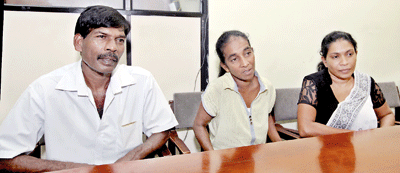
The donor’s father I.G. Nandasena, mother D.P.G. Indra Kalyani and aunt M.H. Janu: The greatest ‘alms’
Soon after Consultant Neurosurgeon Dr. Leslie Siriwardana and Consultant Neuro-Anaesthetists Dr. Ravi Weerakoon and Dr. Udaya Karunaratne gave the go-ahead on brain-dead Sampath, this donor was wheeled into OT A. Scrubbed up and ready, side-by-side were Dr. Abeywickrama and his team and veteran Consultant Transplant Surgeon Dr. P.K. Harischandra and his team.
Simultaneously, the heart, the liver, the pancreas, the kidneys and the eyes were retrieved.
It is Consultant Cardiothoracic Surgeon, Dr. K. Gnanakanthan, who gives the details of the procedure he performed along with Consultant Cardiothoracic Surgeon, Dr. Muditha Lansakara. The donor’s blood group and other necessary matches with the recipient had already been done, with both pre-op and post-op management being handled by Consultant Paediatric Cardiologist Dr. Sunethra Irugalbandara of the Sirimavo Bandaranaike Hospital and Consultant Cardiologist Dr. Roshan Paranamana of the Anuradhapura Hospital.
The retrieval was set for 7 p.m. with Dr. Abeywickrama sawing open the chest and peering closely at the donor heart. “He inspected the heart and found that it was contracting,” says Dr. Gnanakanthan, adding that the “donor heart was good”. It was only then that recipient Kumari was wheeled into OT B around 8 p.m.
Thereafter, the donor’s heartbeat was stopped by the administration of cardioplegia (intentional and temporary cessation of heart activity) and Dr. Abeywickrama ‘explanted’ the whole heart snipping it out with the superior and inferior vena cava, the ascending aorta, the main pulmonary artery and the left atrium with the pulmonary veins.
A similar procedure was being performed in OT B, with Dr. Gnanakanthan and Dr. Lansakara putting Kumari on the heart-lung (cardio-pulmonary) bypass machine; stopping her heart, taking it out by cutting very close to the heart, the superior and inferior vena cava, the ascending aorta, the main pulmonary artery and the left atrial wall but leaving behind the posterior left atrial wall and the pulmonary veins.
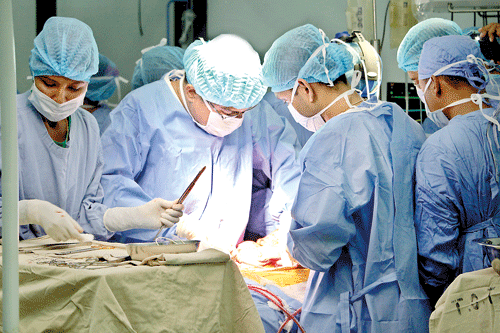
The heart retrieval team at work in Operating Theatre A
Having done the retrieval, Dr. Abeywickrama gently placed the heart covered in cold saline in a silver tray and handed it ever so carefully to the ‘communicators’ who in turn passed it on to the transplant team in OT B. It was on a ‘back-table’ in this OT that the donor heart was “prepared” with slight trimming here and there and cutting open the left atrium.
Easing the new heart into Kumari’s chest, the “stitching” (medically known as anaestomosis) began, starting with the left atrium of the donor heart followed by the pulmonary artery and so on. While the inferior vena cava was being stitched that the first clamp was removed, the new heart perfused and the blood supply restored.
Tangible moments of tension in OT B, a sense of expectation and suddenly murmurs of joy and laughter and sighs of relief, as the medical and surgical teams peered down at the operating table.
The time is etched into the memories of all – 11.14 on the night of July 7……..when the new heart of Kumari began with a slow-beat.
“Thereafter, we provided some electrical activation and the beat became stronger and stronger,” smiles Dr. Gnanakanthan.
The rest, of course, is now epoch-making history, with the transplant patient being taken off the heart-lung machine, stitched up and the chest cavity closed.
For the anaesthetic team, comprising Consultant Cardiac Anaesthetists Dr. Jagathi Perera, Dr. Aruni Jayasekera, Dr. Priyantha Dissanayake and their juniors, however, their work is not over as Kumari is still under their care in the CTICU.
Their stress and worry can only be imagined. “None of us had done it before but we read up extensively and felt confident because we have been part of very complex heart surgeries,” says Dr. Perera, with Dr. Dissanayake nodding vigorously.
“Haemodynamic monitoring (whether the circulation is performing its task of oxygen delivery to tissues) is vital, not only to keep the patient alive, but also to prevent any complications,” she says, referring to the many challenges they faced because Kumari’s heart was performing only at 10% when usually it should be 60% and the Ejection Fraction (the percentage of blood leaving the heart each time it contracts) was 10-15. They did not put her under general anaesthesia when inserting invasive lines to monitor pressure etc., but with her cooperation, even though she was scared, did so under local anaesthesia.
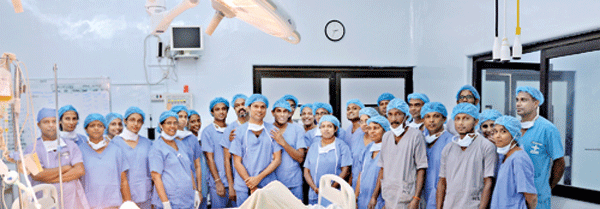
After a hard night’s work, the Operating Theatre staff pose for a group photograph
When under general anaesthesia and on the heart-lung machine, the tasks of the anaesthetic team would make a difference between life and death, as they had to maintain her pressure and ensure that all her other vital organs would not be endangered in any way.
“Kumari’s diseased heart was quite huge,” says Dr. Perera, while Dr. Dissanayake adds that the donor’s heart when transplanted was tiny, like that of a child.
The anaesthetic team had their anxious moments too – when attempting to send in the pulmonary-artery catheter, with the newly-stitched blood vessel hindering a smooth entry. As such, they had to make do with echocardiograms.
Another stressful moment was when Kumari was taken off the heart-lung machine and her pressure could not be maintained for about 45 minutes, with the anaesthetic team sending in maximum doses of medication and keeping the ECMO (Extracorporeal Membrane Oxygenation) machine, willingly loaned by the LRH, handy. ECMO technology is similar to the heart-lung machine but is more suitable for prolonged use in an ICU.
When on July 8, after Kumari had been transferred to the CTICU, the blood gases being “bad” brought on strong suspicions of a major bleed into the heart, the teams were compelled to open up her heart. This time it was not in the OT but in the CTICU itself, with the area being transformed into a mini-OT, says Dr. Perera.
Paying tribute to the nursing and laboratory staff, she points out that small adjustments and major efforts at making-do, they did to perfection.
Dr. Perera adds that the final scare came in the form of a fungal infection, not spotted earlier but set off from the donor, which they blasted with powerful anti-fungal medication.
By July 9, however, a test feed was given to Kumari, with full-scale nasogastric (NG) feeding on Monday, with the anaesthetic team breathing easy only on Tuesday after all issues had been sorted out.
Others who were of immense support in this transplant were Consultant Haematologist Dr. Sunethra B. Athauda, Consultant Histopathologist Dr. A. Vithanage, Consultant Virologist Dr. Rohitha Muthugala, Consultant Microbiologist Dr. Mahen Kothalawela, Consultant in Transfusion Medicine Dr. Dharma Samarakoon and Consultant Judicial Medical Officer Dr. M. Sivasubramaniam.


